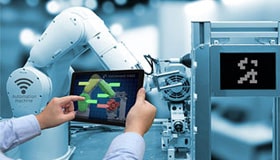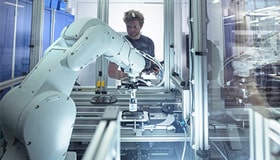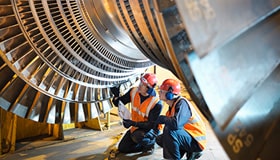Temperature & pressure monitoring for industrial boilers
Introduction
Industrial boilers are used for many different applications in numerous sectors, including paper and pulp, food and beverage, and so on, with the main product being processed steam. Industrial boiler operation can vary significantly between seasons, daily, and even hourly, depending upon the demand for steam. Because the operational period of these industrial boilers increases over time, the temperature and pressure rises continuously. As a result, using industrial temperature and pressure sensors to precisely monitor the temperature and pressure of the equipment in real-time can detect issues early and prevent safety accidents. This article will review how temperature and pressure monitoring works in industrial boilers.
Working of boiler
Boilers use a combination of radiation, convection, and conduction to convert heat energy into steam energy. Consider the simple boiler depicted in Figure 1 to understand how boilers function. A simple boiler is constituted of a heat source, a water drum, an inlet, and a steam outlet. The water drum in this type of boiler is partially filled with water, and heat is applied. Steam is formed when water is sufficiently heated. As the steam leaves the vessel, it is captured and sent to other stages of the process (e.g., used to turn a steam turbine or sent to a heat exchanger to heat a process fluid). Makeup water is added to the drum to compensate for the liquid lost as steam. Boilers use the principle of differential density when it comes to fluid circulation. Boilers must have adequate heat and water flow to function effectively. Pressure, temperature, water level, and differences in water density are all factors that influence boiler operation. When a fluid is heated, the molecules expand and lose density. Convective currents aid in water circulation and mixing when cooler, denser water is supplied to hot water.

Figure 1: Basic industrial steam boiler
There are two types of boilers: low-pressure and high-pressure. Low-pressure boilers, commonly known as heating boilers,
- Steam boilers having a maximum permissible pressure of 15 psi (1 bar) or less.
- Hot water boilers with an allowable pressure of 160 psi (11 bar) or less and an allowable temperature of 250°F (121°C) or less. High-pressure boilers are steam boilers with more significant permissible pressure. They may sometimes be referred to as power boilers, even if the steam they produce does not generate power. Hot water boilers with higher allowable pressures or temperatures are called high-temperature hot water boilers. Some boilers, such as organic fluid boilers, are designed to high-pressure boiler standards regardless of their design pressure.
Boilers must keep a specific temperature and pressure level to operate safely, reliably, and efficiently. Overheating boilers can cause damage, and damaged boilers reduce efficiency, producing operational concerns. Monitoring boiler efficiency can assist increase performance and lifespan. For the industrial boiler manufacturing sector, energy conservation and emission reduction are more than just a phrase; we need to know how to choose the right temperature and pressure sensor to achieve the objective of environmental protection. Pressure sensors can measure pressure in one of three ways: gauge, differential, or absolute. (To understand more about pressure sensors, CLICK HERE).
Temperature sensors are split into two categories contact and non-contact. As the terms imply, the temperature measurement in contact temperature sensors is performed through physical contact with the object or solution. But in non-contact temperature sensors, IR waves or sound waves are utilised to gauge the temperature; hence, physical contact is not required. Thermistors, thermocouples, and RTDs are all examples of contact-based temperature monitoring.
Thermocouples are voltage-based temperature sensors. When two metals are positioned next to each other, and their temperatures differ, voltage is produced. These sensors can detect substantial temperature variations and withstand temperatures up to 1500°C. RTDs, or resistance temperature detectors, monitor temperature by observing how resistance varies in different temperature situations. Integrated assemblies are made up of silicone-encapsulated sensors that may or may not contain integrated circuits (ICs). They offer voltage measurements that may be immediately seen on a linked device's display screen, such as a microcontroller.
Use cases
- Temperature monitoring for CIP processes in brewing systems boilers
Clean and well-maintained brewing equipment is essential for producing the high-quality, great-tasting beer that all brewers strive for. As a result, it is critical that the many tanks and pipelines that comprise a brewing system be cleaned regularly and carefully. Whilst the cleaning was traditionally done by hand, many breweries today, from large-scale commercial operations to small-scale, independent craft brewers, employ automated Clean in Place (CIP) systems to clean and maintain their equipment.
Brewers rely on temperature sensors to accurately monitor the temperature of cleaning agents at various points within a brewing system during the CIP process. Temperature sensors help regulate the process by detecting when the cleaning agent's return temperature has reached the desired set point so timers can be activated. Thermocouples and RTDs have extensively used immersion sensors, although they are unsuitable for brewing systems. Whilst very precise, these sensors are invasive: sensor probes or protective thermowell must be installed, and direct contact with the cleaning chemical is required to monitor the temperature.
An immersion sensor necessitates the installation of a sensor probe inside the pipe, where it can come into direct contact with the process medium. If the medium contains inclusions, such inclusions can accumulate around the sensor probe over time, as seen in Figure 2. This becomes a concern since the accumulation might cause sensor drift and reduce sensor accuracy.

Figure 2: Sensor build-up on an immersion sensor affects temperature monitoring accuracy and clogs pipes.
Omega's new HANI high Accuracy, Non-Invasive Clamp Temperature Sensor brewers have an option. The HANI, which uses multiple sensors and a unique algorithm, is as accurate as invasive immersion sensors while requiring no installation or downtime. That's because the HANI Clamp Temperature Sensor installs in seconds - it can be hand-attached to a suitable pipe and begins recording temperature instantly, as illustrated in the figure 3. The HANI Clamp Temperature Sensor is ideal for use in CIP processes for brewing systems due to its ease of installation

Figure 3(a)

Figure 3(b)
Figure 3: (a) The Omega HANI temperature sensor eliminates sensor build-up. (b) Validation of an existing invasive temperature sensor
- Pressure monitoring in a steam boiler using a pressure sensor
Following temperature, pressure is the second most often monitored process variable in industrial processes. Values such as (gauge or absolute) pressure, differential pressure, level, and flow must be precisely and reliably monitored whenever liquids or gases are transferred, stored, or processed. Steam is used in various industrial applications, including sterilising, heating, and turning generator turbines in power plants in the chemical and pharmaceutical industries. All of these applications need the measurement of filling levels in steam boilers. In many sectors that use process technology, level metering is the foundation for control and process control.
The enthalpy of water plus the vaporisation heat at the relevant pressure would determine the energy necessary to create steam at an absolute pressure in a closed vessel. The enthalpy is calculated by multiplying the temperature difference between the boiler and the boiling point by the specific heat and density.
Because steam boilers are under pressure, differential pressure transmitters (e.g., Omega's DPG409 series and ABB type 266MST) must be used for level monitoring to adjust for vessel overpressure, as illustrated in Figure 4.

Figure 4: Pressure monitoring using differential pressure transmitterss
Differential pressure transmitters are utilised for conventional and demanding applications in automation environments, such as monitoring and safety-related measurements with communication options, including Hart 4-20mA, Profibus PA, Foundation Fieldbus, and Modbus. Depending upon the demand and kind, the measurement error of the transmitters is 0.025, 0.04, 0.06, 0.075, or 0.1% of the rate.
Newark provides a one-stop platform for the key components needed to provide intelligent, real-time monitoring with partners to provide the vital additional products necessary for complete solutions. Some of the products categories of Sensors & Transducers and Sensor Connectors & Components,Temperature Sensors,Flow Sensors,Liquid Level Sensors,Pressure Sensors,Transducers, and Sensor Accessories; these products, as well as the associated ecosystem of its partners, enable real-time monitoring in a wide range of applications in smart industries and facilities for improved reliability and operations.






